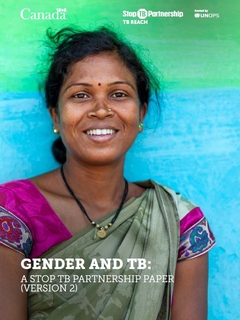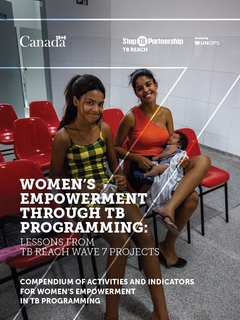Gender and TB
 Gender inequality and discrimination against women, girls, and gender non-binary people is a global phenomenon that is harmful to health. All health responses should seek to minimize inequality and address harmful gender norms. Yet the response to tuberculosis (TB) frequently reinforces harmful gender norms or leaves them unchanged. This includes expectations of free or poorly remunerated labor from community healthcare workers, who tend to be women; exclusion of women from technical and leadership roles; lack of workplace protection for the largely female, lower tier workforce; lack of provisions (such as toilets) in the workplace for women, lack of appropriate diagnostic processes and procedures for women; and pervasive stigmatization of gender non-binary people in healthcare facilities, along with their exclusion in data collection and analysis.
Gender inequality and discrimination against women, girls, and gender non-binary people is a global phenomenon that is harmful to health. All health responses should seek to minimize inequality and address harmful gender norms. Yet the response to tuberculosis (TB) frequently reinforces harmful gender norms or leaves them unchanged. This includes expectations of free or poorly remunerated labor from community healthcare workers, who tend to be women; exclusion of women from technical and leadership roles; lack of workplace protection for the largely female, lower tier workforce; lack of provisions (such as toilets) in the workplace for women, lack of appropriate diagnostic processes and procedures for women; and pervasive stigmatization of gender non-binary people in healthcare facilities, along with their exclusion in data collection and analysis.
For more information refer to the Gender and TB: A Stop TB Partnership Paper which further describes the key gender-related dynamics of the TB burden, the current inequalities within the TB response, and key steps for implementing a gender-based TB response.
Additional Stop TB resources related to TB and gender, can be found on our Gender and Equity webpage. This body of work, including the below TB REACH Wave 7 Women's Empowerments documents, are intended to serve as resources for the design, implementation and assessment of improved, gender-based TB programming.

TB REACH Wave 7 Women’s Empowerment through TB Programming
In recognition of the role that TB programming has to play in changing the broader context of gender inequality, TB REACH Wave 7 funded projects (2019 – 2021), supported by Global Affairs Canada, incorporated a women’s empowerment approach in their program interventions. Although the impact of gender on TB infection and disease is relatively well established, approaches that actively support women’s empowerment through TB programming remain underdeveloped.
In this context, TB REACH and the Wave 7 projects forged new ground in planning and measuring women’s empowerment in TB programming in addition to incorporating gender-based interventions. Valuable lessons were gained from this experience and TB REACH, in partnership with grantees, have developed a series of documents that outline the lessons and insights related to the innovative approaches to gender and women’s empowerment.
- Acknowledgements and Key Definitions
This document acknowledges those who have contributed to this series of work and provides key definitions for a standard set of terms used throughout the series relating to gender.
- Training Healthcare Providers on Gender-Based TB Care Provision
This document outlines content areas and methods for training health care workers on women’s empowerment and gender-based TB care provision.
- Compendium of activities and indicators for women’s empowerment in TB programming
This document sets out potential activities and indicators for incorporating a women’s empowerment approach to health programming, with specific reference to TB. The document additionally contains tools to assess program progress towards women's empowerment and gender equity.
- Women's empowerment through TB programming: Examples of change
This document includes the following set of cases studies reflecting on lessons and insights from TB REACH grantees - Countering women’s digital exclusion through TB programming
- Creating opportunities for empowering female community health workers through TB programming
- Supporting access to financial and income generation resources for marginalized women through TB programming
- Developing and disseminating gender-responsive TB education media
- Bringing women’s empowerment into the organizational space
- Expanding women’s technical capacities in the TB response

